

|
|
Part One: Testing the
|
|
Spyderman started the game in the same fashion as innumerable other Witch Doctors, attacking the zombies outside New Tristram in the scripted event that takes place there. He did not have access to the Corpse Spiders skill immediately, although it would unlock very quickly at level 3. I was forced to use the Poison Dart skill for those first two levels, as I'm not even sure if it's possible to attack without using a signature skill of some kind in Diablo 3. In any case, it only took about five minutes of real world time before Spyderman reached level 3 and unlocked the Corpse Spiders skill:
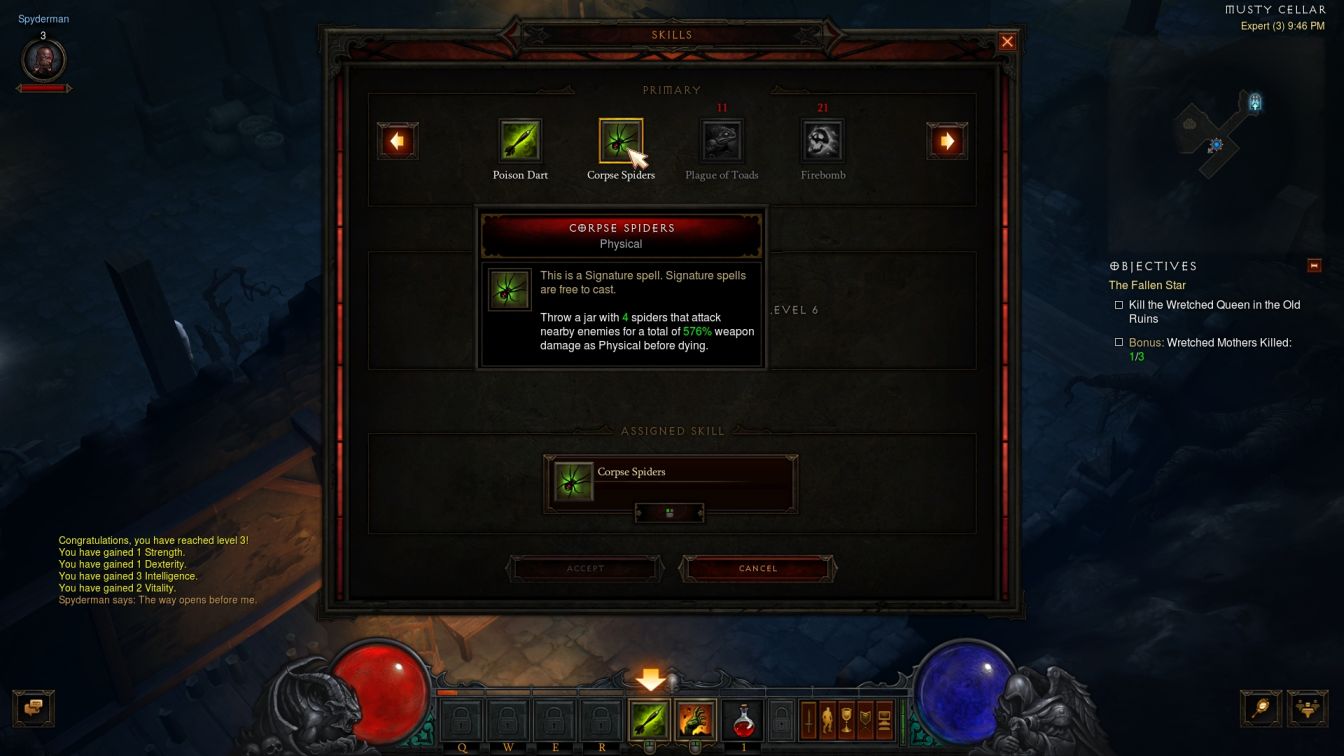
Let's talk a bit about how this skill works since it's going to be so integral to this character's journey. When using the Corpse Spiders skill, the Witch Doctor hurls a jar that shatters on the ground at the location where the player has their mouse cursor pointed. Four spiders burst out of the jar and will attack any hostile targets in the area, disappearing after about three seconds. There are several major advantages to this skill, starting with the fact that the damage is quite high for a signature skill. All skills in Diablo 3 deal damage based on your weapon's DPS (damage per second) rating, expressed as a percentage of that DPS output. Corpse Spiders deals a total of 576% weapon damage, which again is quite good for a signature skill. Most of these "free" skills deal around 200-300% weapon damage by way of comparison. Corpse Spiders deals damage more like a "normal" skill which is part of the reason why I reasoned this variant would be conceivably possible. There's no limit to the number of spiders that can be on screen at once, and getting additional attack speed to throw more jars at a time helps a lot with this skill. The spiders are pretty good at seeking out enemies to attack even if the jar isn't placed right on top of them, and the damage output when all of the spiders attacked a single target at once was pretty immpressive.
Another advantage of the Corpse Spiders skill is the range. The Witch Doctor must have a pretty good arm because the jars can be thrown literally anywhere on screen that the mouse cursor can reach. You can throw them up or down cliffs and hit targets that otherwise look to be out of range. Basically, if you can click on it the Witch Doctor can toss spiders there. This would come in handy for hitting out of reach opponents and waking up bosses at a safe distance. Finally, Corpse Spiders also costs no mana by virtue of being a signature skill, which meant that Spyderman would never have to worry about running out of his class resource. In fact, all of his planned skills cost no mana to use. This would be the rare case of a completely manaless character, and I would be able to skip out on anything involving extra mana or mana regeneration in terms of Spyderman's build.
With that said, there were some serious drawbacks to the skill as well. The biggest disadvantage to Corpse Spiders is the fact that it locks the Witch Doctor in place for the duration of its casting animation while the jar is being thrown. While this is not a channeled spell like Inferno from the previous Diablo games, it's also a lot slower than many of the other skills that can be fired off while on the move. Spyderman would end up doing a lot of kiting backwards against various enemy mobs, and his constant need to keep stopping to throw more spider jars forced a lot of stop-and-go action. (It was a lot like playing a ranged carry in League of Legends, lots of Shift-click auto attacking.) The other big disadvantage of Corpse Spiders as a skill is the inability to control the little spiders once they hit the ground. The player gets to control where the jar lands but nothing after that. This is a real problem against the major bosses that keep summoning more minions, as the spiders can't be instructed to focus only on the boss. The inability to prioritize certain targets was a major drawback. And of course the nature of the skill made it somewhat of a damage-over-time (DOT) effect, not something that could deal damage in an upfront burst. The Corpse Spiders skill needs multiple jars hitting the ground to be truly effective - one or two of them doesn't do much on their own.
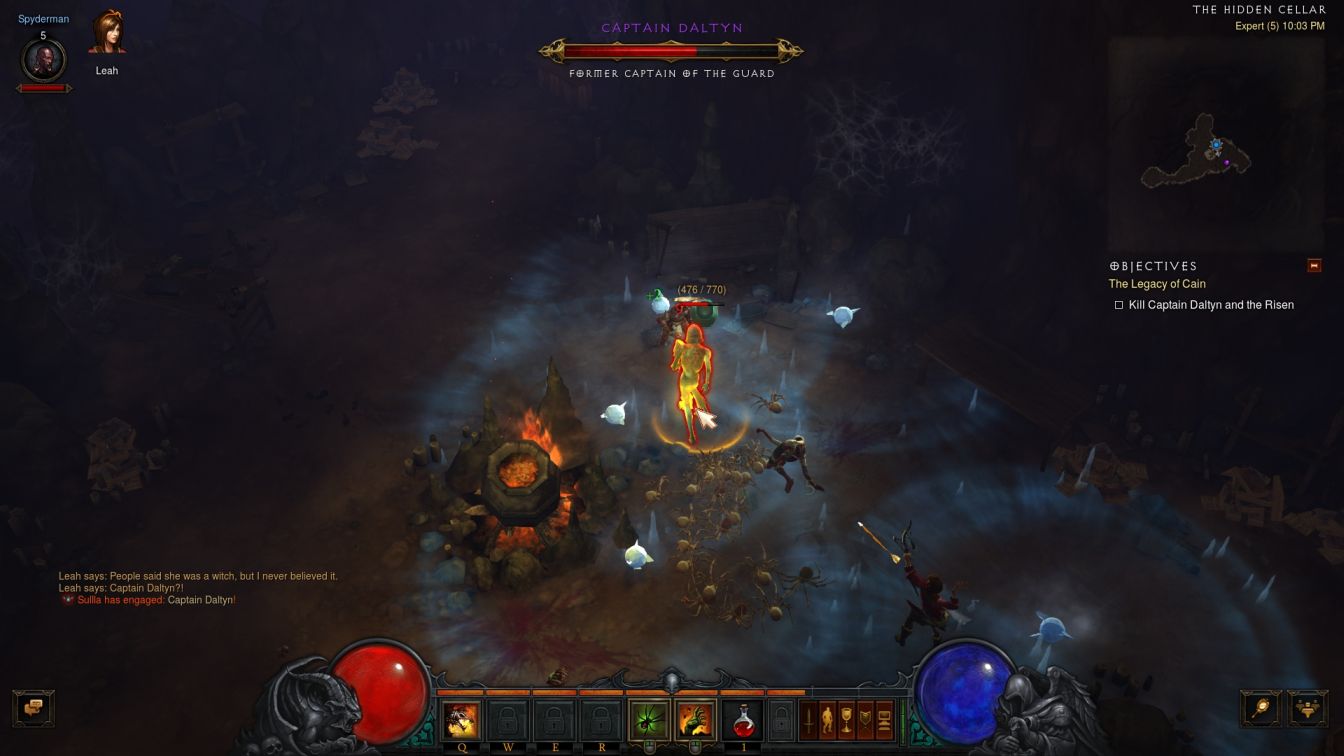
Spyderman's first use of Corpse Spiders made for relatively slow going. The skill might deal 576% weapon damage in total, but each of the four spiders only deals a quarter of that, or 144% weapon damage each, and then that damage is divided out over the duration of each spider's brief lifespan. In practice, this meant that the weapon DPS rating of 5 damage that Spyderman had at the start of the game was translating into 2 or 3 damage attacks from the spiders. Each spider would get off a few attacks before perishing and there were four of them from each jar... but still, a lot of little "2" and "3" damage printouts popping up above the heads of the zombies. For context, these undead opponents had about 100 life each. Fortunately they were pathetically slow and not dangerous in the least. The first enemy to present any kind of a threat was the Captain Daltyn boss pictured above, and only because he had drawn Frozen for his boss ability. This ability causes little ice rings to appear on the ground and detonate after a few seconds, freezing the player if caught inside when they explode. Note the huge mass of spiders attacking Captain Daltyn from all of the jars thrown out by Spyderman, pinpricking the boss for 2 or 3 damage at a time. It took about a minute of running in circles to defeat this opponent.
Spyderman picked up a few levels by the time that he entered the Cathedral for the first time. A note on difficulty is in order here for those who haven't played Diablo 3. Like the Elder Scrolls games, the monsters level up alongside your character here in the Reaper of Souls expansion, continuously gaining additional health and damage with each character level. In practice, this means that your character must keep upgrading to better gear or else you're actually getting weaker as time goes on. Fortunately there are lots of tools in Reaper of Souls to make upgrading your character a fun task instead of the tedious slog that it was in the release version of the game. I hadn't found anything too great yet in terms of a weapon and it was slow going for the moment, dealing 3 damage at a time against monsters that were scaling up to 200 and 300 life apiece.
The first breakthrough in terms of item luck came from a Treasure Goblin:
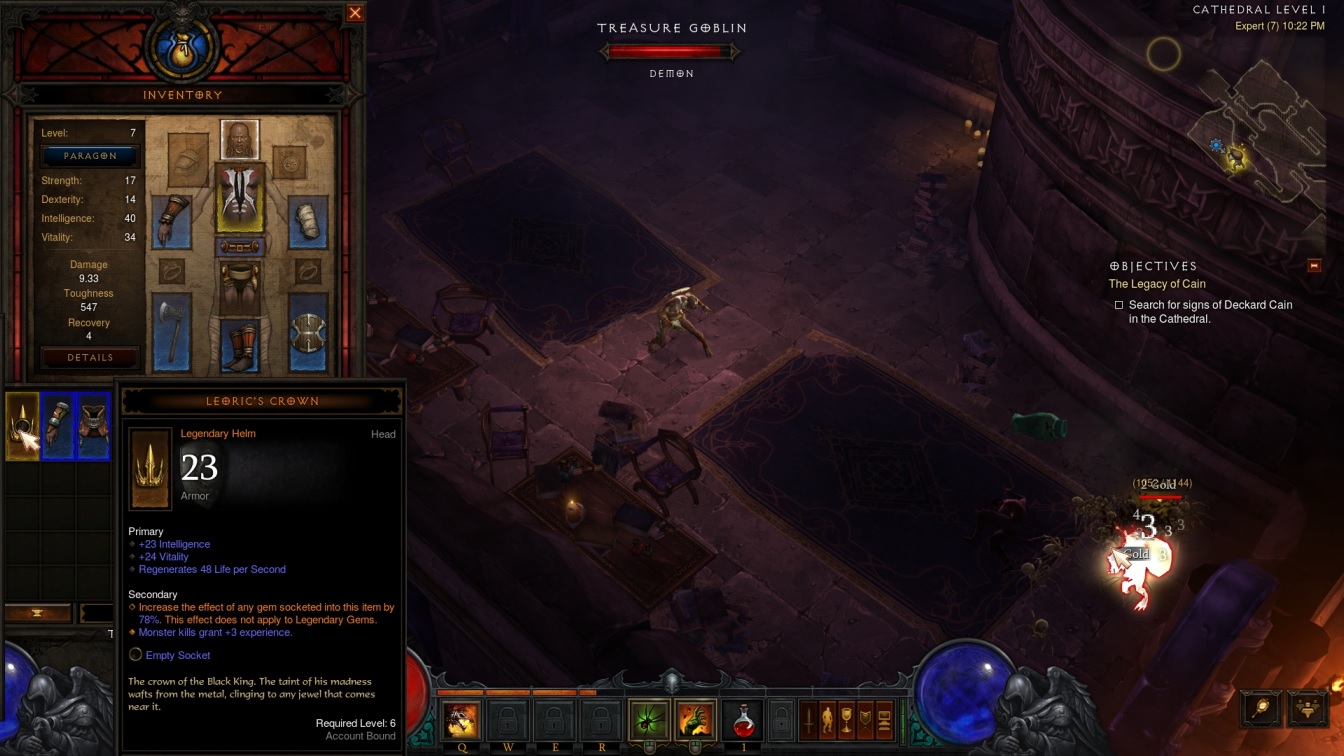
Treasure Goblins are a new addition to Diablo 3 not present in the first two games. These are rare monsters with high health that made no attempt to attack, and instead run around trying to escape after showing up on screen. Players want to kill the Treasure Goblins because they have the potential to drop excellent loot, but they will often run into unsecure areas and wake up lots of other enemies in the process of hunting them down. Great gameplay concept on the part of the design team. Spyderman was able to trap this particular Treasure Goblin in a corner of the Cathedral architecture where no escape was possible, then swarm it under dozens of biting spiders. Yikes, a painful death there for the poor goblin. It dropped Leoric's Crown, the first legendary item of Spyderman's journey. Legendary items will have different stats depending on the character level at which they appear (some will only show up for level 70 characters) and the class of the character who spawned them via the "Loot 2.0" smart drop system. However, most legendary items have some kind of unique secondary ability that's always present no matter when they appear. Leoric's Crown always shows up with an empty socket and the unique property to increase the effect of the gem placed into that socket by 75-100%. I would end up putting amethysts into this socket because they add to maximum life, taking advantage of that +78% bonus to get a huge increase in total health. Even the non-unique bonuses were all excellent here: +23 Intelligence and +24 Vitality increased both stats by more than 50%! And the 48 life/second regeneration was massive for this early in the game. Spyderman would end up wearing Leoric's Crown for a very long time.
Leoric's Crown almost doubled the damage output of the Corpse Spiders, hopping up from 3 damage apiece to 5 damage apiece. This sped up the clear pace through the Cathedral noticeably, with Spyderman heading down to Leoric's Passage and eliminating the boss down there (Headcleaver) with no issues. It wasn't much longer before he hit character level 8 and unlocked his first supporting skill: Horrify.

Horrify is a skill that causes the Witch Doctor to don a spectral mask that fears all nearby enemies for 3 seconds, with a cooldown of 10 seconds before it can be used again. The enemies that are terrified will stand rooted in place without moving for the duration of the skill. This was another skill that cost no mana to use, albeit with the downside of having rather short range in terms of which opponents were affected. I noted right away that Horrify was not a targeted skill, and would instead hit everything within a short distance of Spyderman's position. That made it less useful than the Necromancer's Terrify curse from Diablo 2, which could be targeted on the map away from the character's own position. Still, beggars couldn't be choosers and this was another tool in Spyderman's arsenal. He was pictured above using it against one of the many minor bosses (or "elites" as they are now officially named in D3) with the little skull icon indicating that the fear effect from Horrify was in use. There's a neat graphical effect when Horrify is used whereby a big voodoo mask appears on the screen, something I'll try to capture in later screenshots.
When Spyderman hit character level 9, he unlocked his first rune for the Corpse Spiders skill:
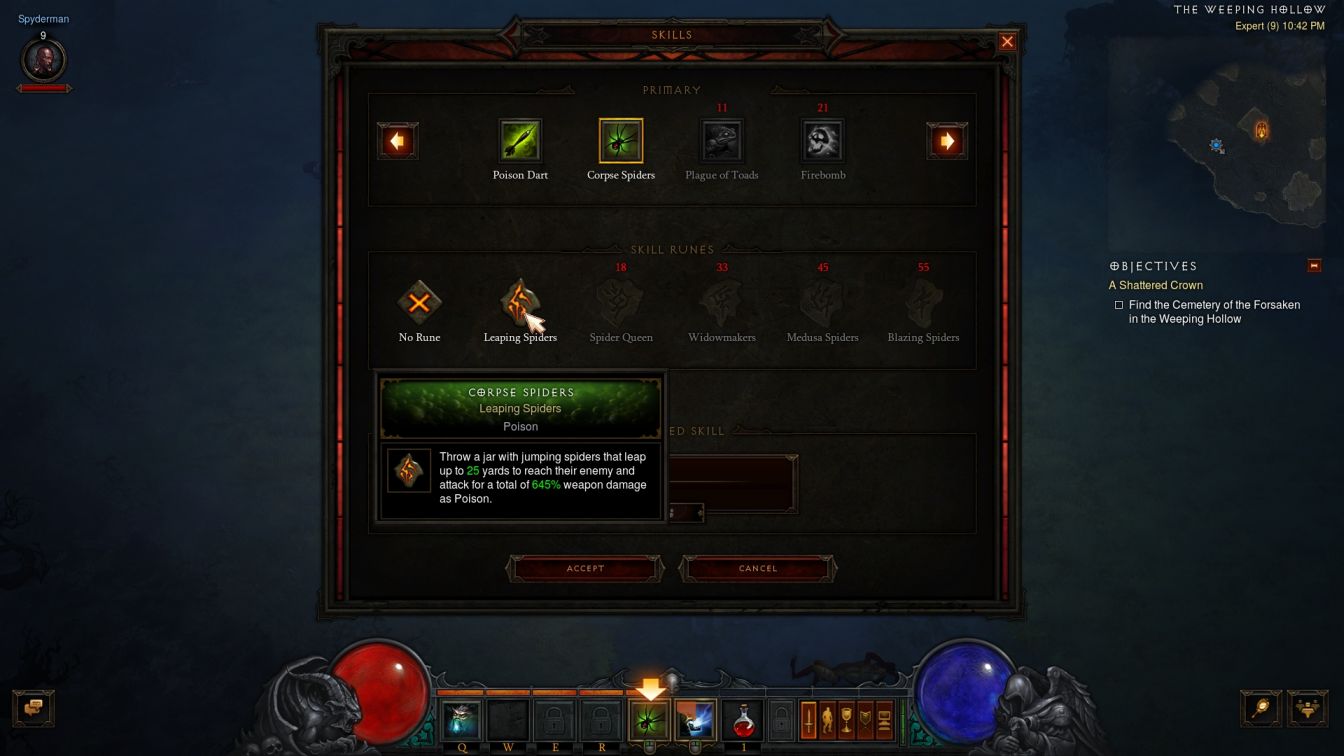
The runes in Diablo 3 are supposed to be a replacement for the skill point system from Diablo 2, providing five variations on how the core skill can be used in different ways. They are a poor replacement though, as in practice one of the five runes is nearly always the best choice and gets used by basically everyone. The whole system is passive in nature, with each rune unlocking automatically as your character levels up, and there's no option to emphasize a certain skill or assign points between competing options. Hopefully this will be scrapped as a failed mechanic for Diablo 4 and replaced with something more interesting. Anyway, Corpse Spiders would gain different rune options at character level 9, 18, 33, 45, and 55. Much like the different civic options in Civ4, the later runes are not necessarily better than the earlier ones in Diablo 3. Leaping Spiders was a no-brainer though, as it would increase the damage of the skill (from 576% weapon damage to 645% weapon damage) and also added a leaping ability to the spiders themselves. I found that the non-leaping spiders didn't seem to have much trouble targeting enemies but sure, why not. The damage type also changed from physical to poison in nature, which I suppose could be important to note against opponents that were heavily poison-resistant. I've been unable to find much information on monster stats in D3 though, and I'm unaware of which enemies are strongly resistant to certain damage types. There are no monster immunities as in previous Diablo games and frankly I'm glad of that. The common use of immunities in Diablo 2 largely served to break variant builds without making the gameplay particularly interesting.

The next couple of areas were largely uninteresting as Spyderman progressed through the wilds of Act I. These outdoor regions were not as visually appealing as the Cathedral, which clearly received a ton of developer attention since it was the area used in the free downloadable demo. The combinaton of the Leaping Spider runes and some gear upgrades had the individual spider damage all the way up to about 18 per attack, tripling the damage from a few levels earlier. This was one point in time where Spyderman's damage output had outscaled the increases in monster health/damage, and his pace had increased to a brisk walk, almost as fast as a non-variant character would be moving through this region. I had thought that Spyderman might be too weak to get the "massacre" bonuses for killing large groups of enemies, but nope, he was handling them just fine despite his gimped setup.
Part of the reason why his damage output had gone up was due to the use of a new skill named Soul Harvest. This is one of the core skills for any Witch Doctor build, something that even the power players with all the high end gear use in their setups. Soul Harvest sucks out the life energy of nearby monsters and grants the Witch Doctor +3% Intelligence for the next 30 seconds, stacking up to five times. Since the skill itself has a 12 second cooldown, in practice it's fairly easy to get up to the maximum of five stacks and keep Soul Harvest there. The one downside is that Soul Harvest does have relatively short range, the same 18 yard radius as Horrify in fact, and it's somewhat annoying to have to recast this skill every 12 seconds basically forever. However, gaining +15% Intelligence at max stacks is pretty awesome and it definitely made a difference in the damage being dished out by the Corpse Spiders. To use another League of Legends analogy, this was a bit like keeping a Rageblade stacked up in combat.
I had been making excellent process in recent areas, and that may have caused me to be a bit careless. Down in the Defile Crypt, Spyderman came across a boss pack of scavengers and for the first time in the game he was completely swarmed. There was a monster on every side of him and he couldn't move, trapped in place by the ravenous undead. Now I had a plan for this in his character build, the use of the Spirit Walk skill to run out of trouble, but there was one problem: Spyderman hadn't unlocked the skill yet. Whoops.  I drank the one Potion allowed in Diablo 3 for the 60% health restoration but it wasn't enough. RIP Spyderman:
I drank the one Potion allowed in Diablo 3 for the 60% health restoration but it wasn't enough. RIP Spyderman:

That would have been the end of his journey if Spyderman had been a Hardcore character. Fortunately I could keep going since this was a Normal character, however it did serve as a bit of a wakeup call. I had indeed been playing a little bit too fast and loose with Spyderman, running up into the face of enemies to get off his damage faster, and until I had the Spirit Walk skill I would need to be more careful. A huge problem here was the inability to target certain opponents with the Corpse Spiders. I could not focus Spyderman's damage on an individual skeleton, kill it, and then run out to safety. The little spiders just hit everything at once without any control over them, and that meant that there had been no opportunity to break free of this trap. As far as I was concerned, this death didn't really "count" since Spyderman was lacking a critical part of his character setup designed specifically to deal with these threats. Spirit Walk was only two levels away, and I resolved not to get caught like this again.
When Spyderman hit level 15, he was able to craft a rare weapon from the Blacksmith for the first time:
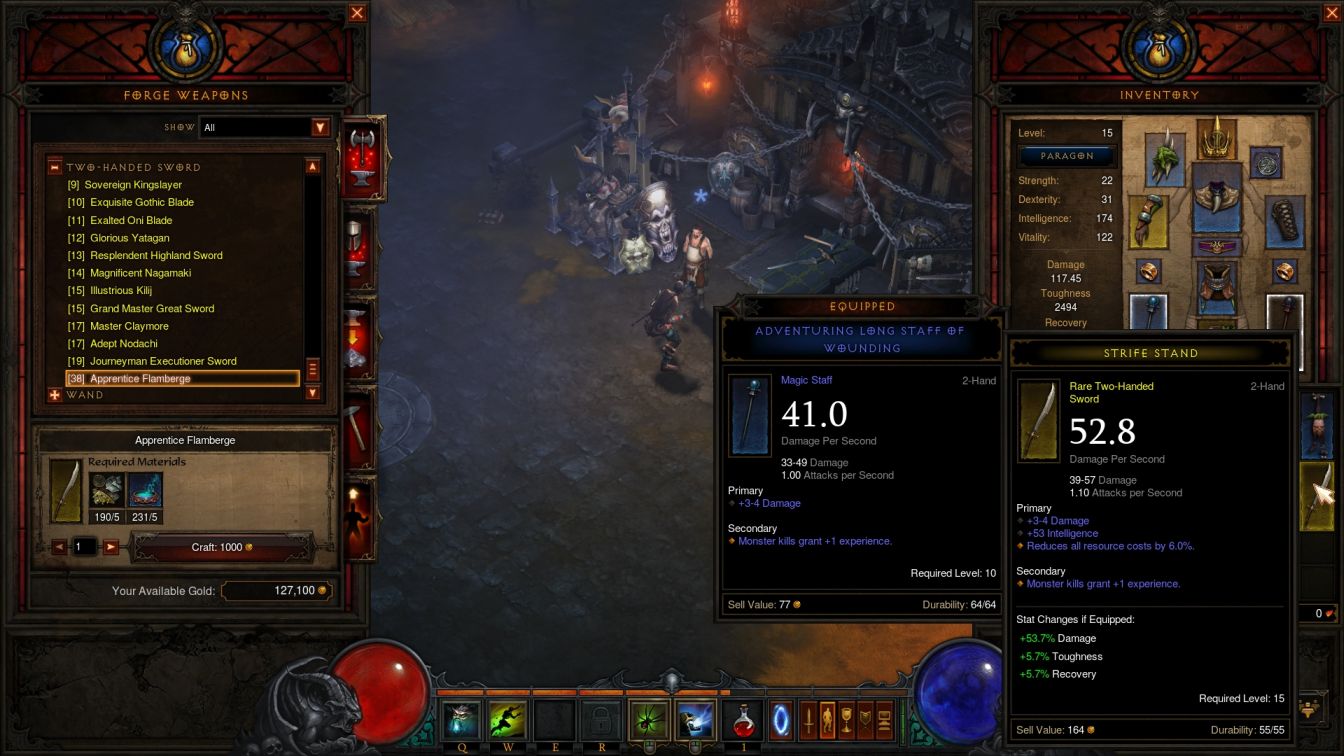
The way that the basic crafting works is that the Blacksmith has a bunch of different recipes to choose between for each item type, each with an increasing level requirement. The "Apprentice Flamberge" is the most basic crafted item in the Two Handed Sword category, for example, and then it works its way up the list until reaching the "Sovereign Kingslayer" at the top. All of these weapons are exactly the same for all intents and purposes, just with a higher level requirement attached. Your character will always want to craft the highest allowable item in each category when creating a basic rare item. In the post-level 70 endgame, things get more complicated and there are different legendary and set items that can be crafted in each category. For the moment though, things were pretty simple. The Apprentice Flamberge required 5 of the "white" crafting materials from normal items and 5 of the "blue" crafting materials from magical items. These are obtained from salvaging items at the Blacksmith, which is usually the best thing to do with unwanted gear. You need a ton of crafting materials in Diablo 3 and selling items doesn't yield much in terms of gold. I was tracking Spyderman's gold and crafting items separate from what my non-variant Monk character had saved up, and he had enough to create this new sword. Click the "Craft" button and presto, one new weapon.
The new two handed sword was MUCH better than the crummy wand that I'd been using up to that point. Note the comparison from hovering over the two items: +54% Damage along with +5.7% Toughness (basically survivability) and +5.7% Recovery (health regen). Now you might be saying to yourself, wait a minute, I can see the damage rating and the new weapon only went up from 41.0 to 52.8 DPS rating. How in the world does that translate into an increase of 54% damage? The answer lies in the big boost to Intelligence on the weapon, +53 points to Spyderman's primary stat. Your class primary stat serves to increase your damage, +100% damage for every 100 points of the primary stat, and therefore Spyderman would be going from 174 Intelligence = +174% damage up to 227 Intelligence = +227% damage. The higher base damage plus the higher Intelligence scaling was enough to increase the total damage output by about 50%. This can get pretty complicated when things like attack speed and critical hit chance/damage get factored in, and it's very helpful that Diablo 3 does the math for players automatically. The general rule for all characters is to stack as much Vitality and primary stat (Intelligence for Spyderman) as possible at all times, then figure out the rest later.

With the newly crafted weapon in tow, Spyderman's damage output jumped upwards once again. If you look closely at the screenshot above, the damage output from the individual spider bites was now displaying in the 89-99 damage range. Of course his skeletal opponents also had more life than they'd possessed earlier in the game, sitting around 500 HP as opposed to the 100 HP from before, but it made a big difference to be dealing a little under 100 damage per spider attack instead of 2-3 damage. As always in Diablo 3, having a better weapon made all the difference.
The Spirit Walk ability had also unlocked at character level 16, and it deserves some discussion of its own. Spirit Walk is another skill with no mana cost to use on a 10 second cooldown timer. The skill transforms the Witch Doctor into a glowing skeleton for 2 seconds, allowing him to run through enemies while moving at a much faster speed for that brief duration. From what I could see while playing, the monsters ignore a Witch Doctor while he's passing through the spirit realm, failing to attack or use any of their abilities. This is therefore a fantastic skill to use for disengaging from bad situations, and the biggest problem that I had with Spirit Walk was continuing to stand in place auto-attacking by accident instead of running away. I was doing a ton of Shift-clicking with Spyderman, which is the command in Diablo to attack without moving your character. This is the only way to attack without having a target selected, something that Spyderman did constantly. I had to remember to let go of the Shift key to disengage after popping Spirit Walk, or else he would stand in place and keep attacking rather than fleeing to safety.

I had been looking forward to Spyderman reaching character level 18 where the Spider Queen rune would unlock for his Corpse Spiders skill. This rune changed up the function of the skill in a fundamental way, creating a single Spider Queen rather than a mob of little spiders. I was salivating at that 2625% weapon damage reading and thought that this might be the core rune that Spyderman would use going forward. However, in practice this rune ended up being a huge bust. The Spider Queen rune only allows for a single big spider to appear on the screen at a time; clicking to attack again only broke open a jar creating a replacement spider queen, not a second one. There was no way to keep attacking and stacking up damage with lots of lots of little spiders. Furthermore, the spider queen dealt that 2625% weapon damage over 15 seconds, which is pretty terrible once you think about it. The per-second weapon damage was only 175% which is awful. And while the spider queen was OK at dealing with single target opponents, it was even worse than the swarms of little spiders at dealing with the huge numbers of undead opponents that were common throughout Act One. Spyderman was pretty much reduced to throwing a single jar and then standing around dodging while the spider queen slowly whittled down the enemies. No thank you.  At least with the other runes I was playing an active game, either tossing out more jars as fast as possible or dodging monster attacks. I went back to the Jumping Spiders runes as it was clearly the superior option.
At least with the other runes I was playing an active game, either tossing out more jars as fast as possible or dodging monster attacks. I went back to the Jumping Spiders runes as it was clearly the superior option.
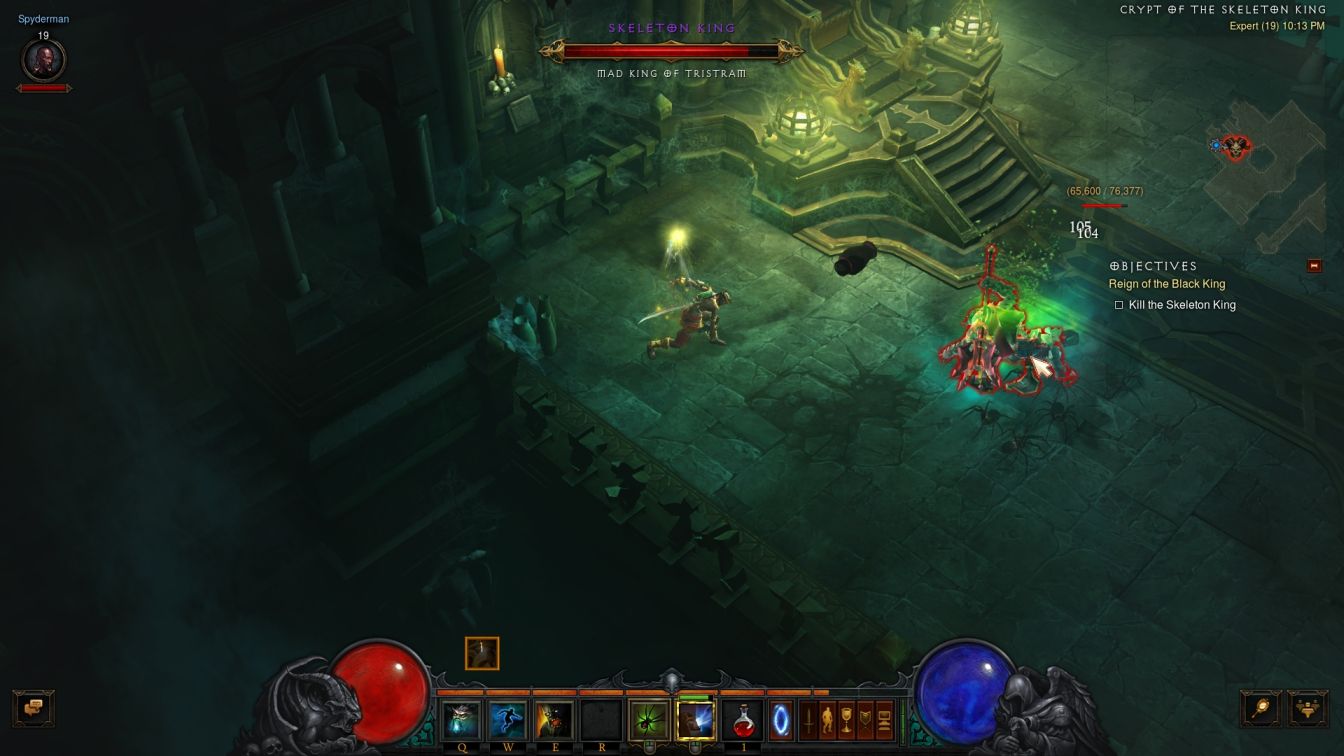
The first true boss of the game takes place about a third of the way through Act One, in the form of King Leoric. This was the boss at the end of the demo and this fight at the bottom of the Cathedral is a gorgeous visual experience even with the passage of time since Diablo 3's release. Leoric is pretty easy as far as bosses go, with his attacks largely consisting of several highly telegraphed swinging stabs forward interspersed with the summoning of skeletal minions. I was a little bit concerned about the minions due to the low DPS output of the Corpse Spiders, but fortunately they handled this battle without a hitch. I really had nothing to worry about as Spyderman had enough health regen to face little danger from Leoric. Even eating a full combo from the boss would only take out about 25% of Spyderman's health globe, and he would regenerate back to full before the next sequence of attacks arrived. As I've written before, this was Diablo 3's Fake Difficulty in action and Spyderman was on the positive side of the dividing line. His gear was good enough that it was essentially impossible to lose, even with an offensive output based around wacky spider jars. The boss went down after about two minutes of fighting.
The next major change in Spyderman's skill setup came at level 22, where he unlocked his final two skills:
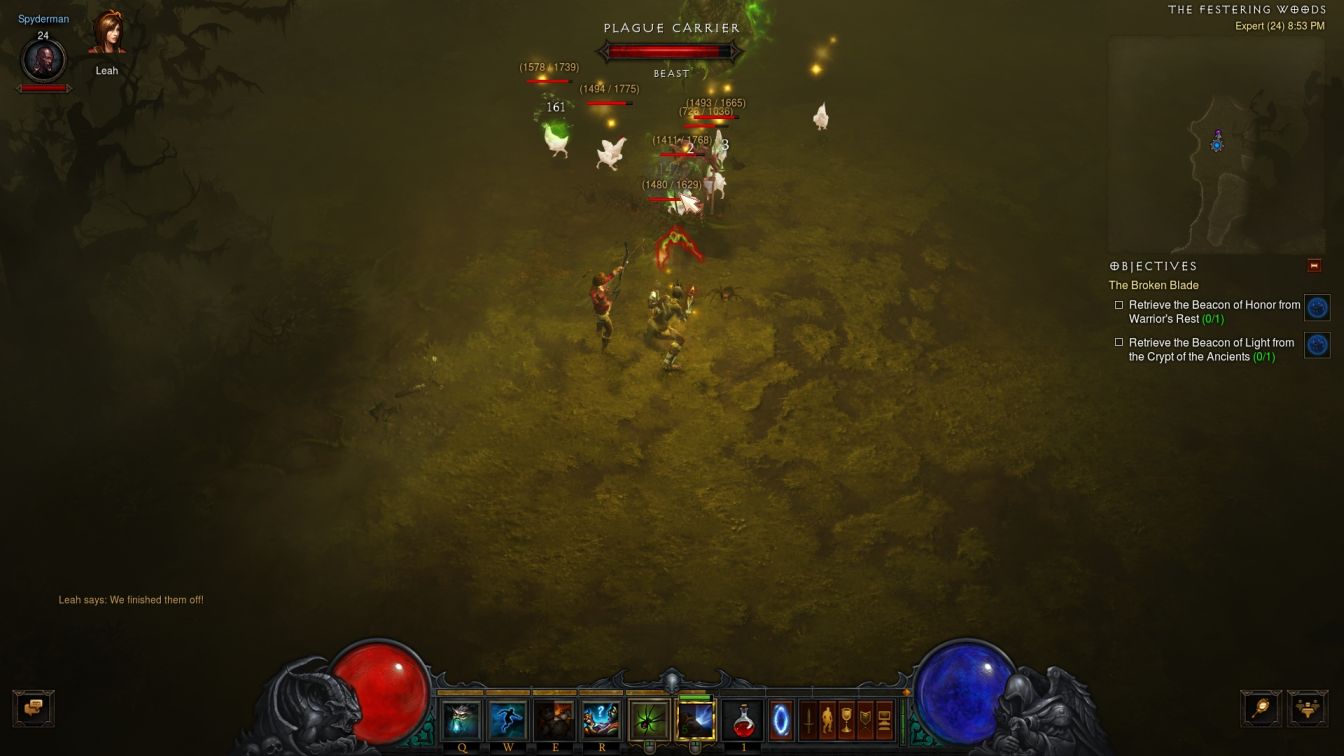
The first of these was the Hex skill. It summons a Fetish Shaman, looking just like the totem-pole fetishes from the jungles of Diablo 2, which hexes enemies by transforming them into chickens. The transformed enemies stand around helplessly unable to do anything, making them easy prey for the Corpse Spiders to attack. The Fetish Shaman summoned by the Hex skill lasts for 12 seconds and the cooldown for the skill is 15 seconds, making it possible to have the skill up and running nearly all of the time. (With some cooldown reduction it's possible to reach 100% uptime for the skill.) I had no idea what to expect from this skill and I found myself pleasantly surprised by how effective it was. The Fetish Shaman would curse roughly half of the monsters in the immediate vicinity, and it could strike them more than once over the duration of those 12 seconds. This also wasn't an ability that only affected the random lowlife critters either; I found that the elite mobs were just as vulnerable to being transformed into little chickens. Everything other than the major set piece bosses seemed to be vulnerable to this skill. I found myself using Hex enough that I switched it over to my primary hotkey on the "Q" key, shifting Horrify and Spirit Walk over to the right since they saw more situational use. I tried to have both Hex and Soul Harvest running essentially all of the time for Spyderman.
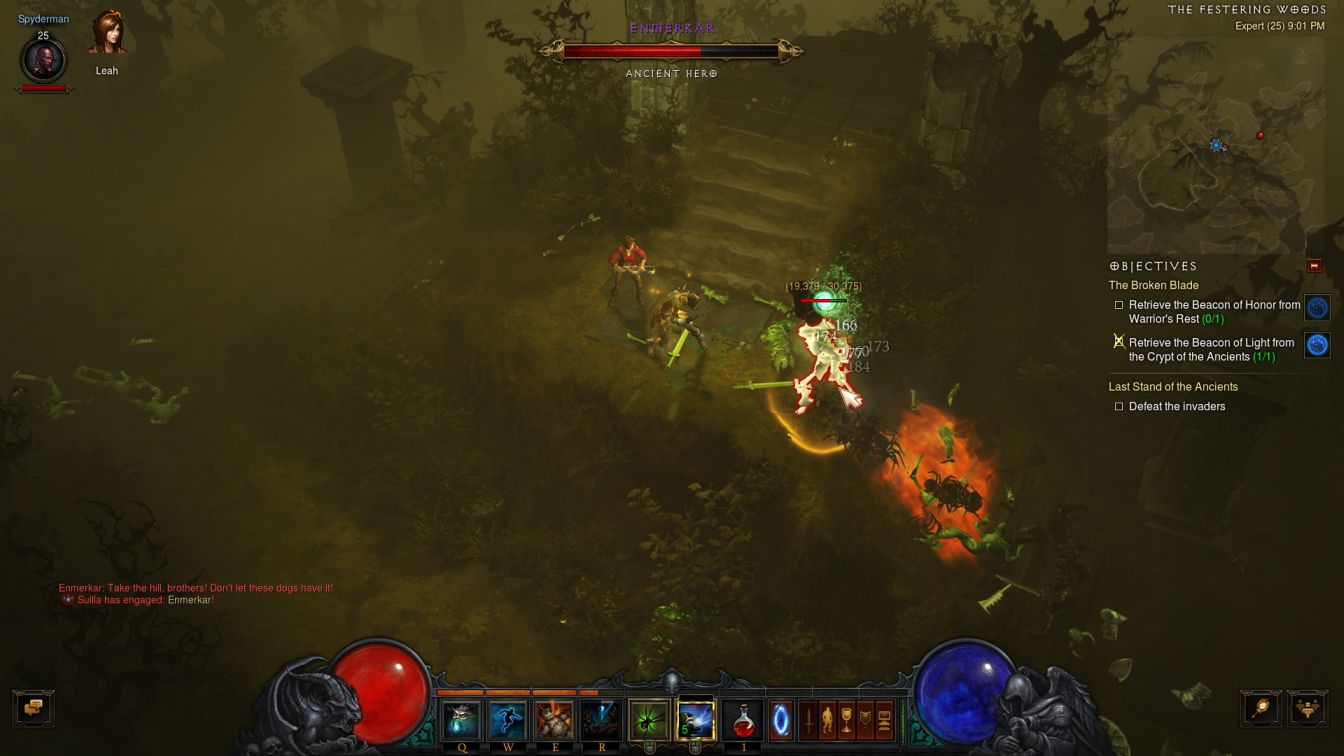
The other new skill that unlocked at the same time was Mass Confusion. This skill does exactly what the name suggests, inciting paranoia in nearby enemies and causing them to fight against one another for 12 seconds. The "charmed" form of crown control is indicated by a little blue-green spiral icon above the heads of the affected monsters, as pictured on the elite opponent above. Mass Confusion was another ability similar to Soul Harvest and Horrify, automatically targeting enemies within a circular radius around Spyderman's position. It was not a targeted spell like Hex, the only one of Spyderman's non-Corpse Spiders skills that he could aim. Mass Confusion proved to be extremely helpful at dealing with large mobs of enemies, even if it did require that Spyderman get close to the danger zone in order to get off the charming ability. The big downside was the cooldown timer which came in at a hefty 60 seconds. I basically thought of this as something like an ultimate from League of Legends, even mapping Mass Confusion to the "R" key and breaking it out in the most dangerous situations. If anything, I tended to underuse the skill out of fear that Spyderman would need it in a more serious situation later and not have the thing off cooldown. Better safe than sorry and all that.

Amusingly enough, one of the areas visited in Act One consists of a cavern full of enemy spiders. This was a place where Spyderman felt right at home, and I was gratified to notice that his Spirit Walk ability would break him out of the webs that otherwise slowed his movement. (Spirit Walk will also break the Witch Doctor out of the Frozen and Jailor conditions, another aspect that came in extremely handy.) I was full-clearing each area with Spyderman and eventually made my way to the boss at the end, Queen Araneae. Her fight is also highly scripted, breaking off the combat at 2/3rd and 1/3rd health remaining to retreat into the nearby tunnels and summon additional spiderling minions. The Corpse Spiders didn't have any more trouble here than they'd had against Leoric (note the smashed spider goo in the above picture), and this was another victory with no serious danger incurred. Spyderman's health regen was simply too high to be in any real danger.

Here's the full skill layout for Spyderman at this point along with the passive skills that he was running. Most of the runes in play had relatively modest additional functions, such as the Siphon rune on Soul Harvest stealing away a small amount of health from affected enemies and the Stalker rune on Horrify increasing movement speed for 4 second after using the skill. The passive skills deserve a mention though since I haven't covered them previously. All classes get to pick between a series of different passive skills to go along with their six active skills, although again in practice there are only a handful that are typically useful for each class. Pierce the Veil was the clear best choice for Spyderman: all damage increased by 20% at the expense of 30% higher mana costs. The joke was on the game here - none of his six skills used mana!  Spyderman had unlocked this at level 27 and made use of it right away. Newly added at level 30 was the Spirit Vessel skill, granting him a one-time save from death every 60 seconds. Each class seems to have something like this and it's always my top choice even when not playing Hardcore characters. I hate dying and I try to do everything possible keep my characters alive. The third option here was Zombie Handler, a weaker choice that increased Spyderman's life by 20%. Most of the passive skills had something to do with mana or mana regeneration in some way, and this was therefore the strongest option that actually did something. I planned to replace it later as more passive skills became available.
Spyderman had unlocked this at level 27 and made use of it right away. Newly added at level 30 was the Spirit Vessel skill, granting him a one-time save from death every 60 seconds. Each class seems to have something like this and it's always my top choice even when not playing Hardcore characters. I hate dying and I try to do everything possible keep my characters alive. The third option here was Zombie Handler, a weaker choice that increased Spyderman's life by 20%. Most of the passive skills had something to do with mana or mana regeneration in some way, and this was therefore the strongest option that actually did something. I planned to replace it later as more passive skills became available.
Sometimes the fights could get pretty busy out there in the wilds:
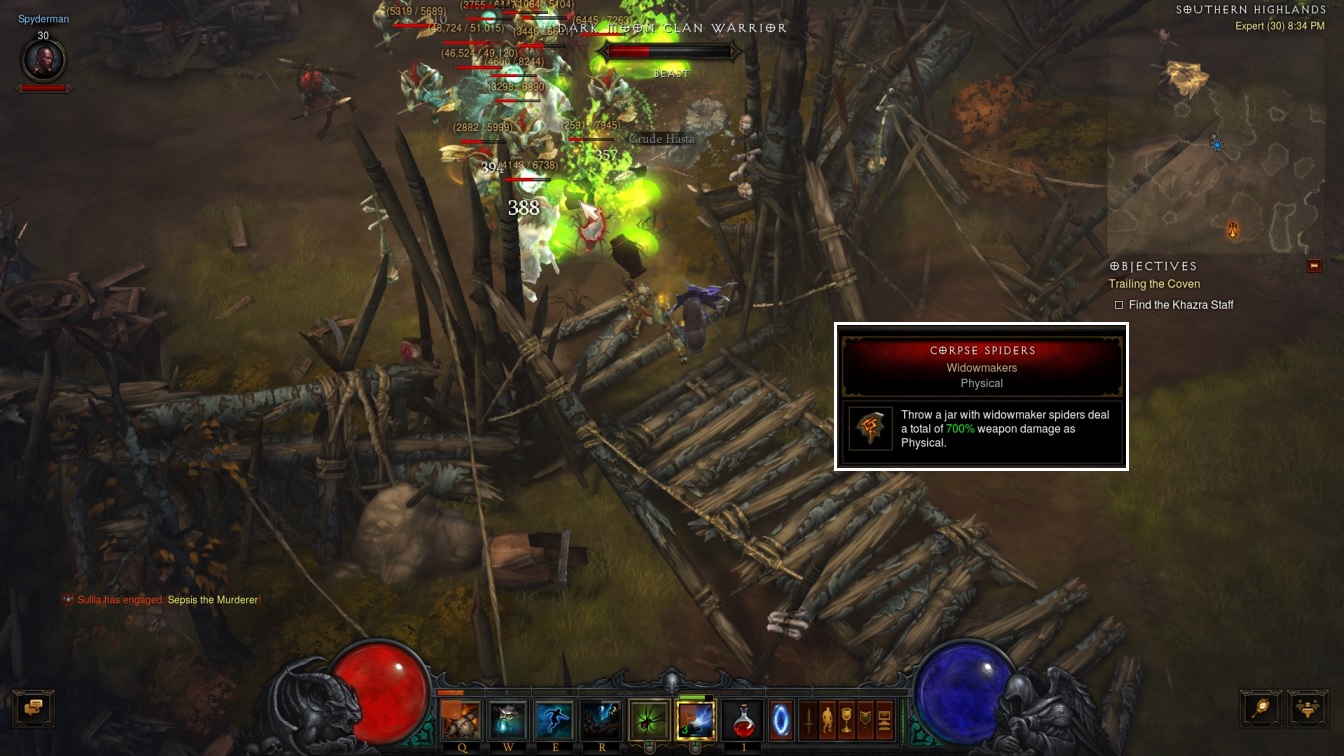
This was what a typical large battle would look like against an elite mob, which apparently rolled the Poison Enchanted trait based on the green slime pictured above. Spyderman would toss out his Fetish Shaman with the Hex ability to start transforming some of the monsters into little chickens, then race in to get off a Soul Harvest cast and apply Mass Confusion. Almost half a dozen monsters in the pictured example were charmed by his Mass Confusion ability, and many of the opponents not charmed had been hexed into non-threatening chicken status. With the foes attacking one another or cowering in helpless inaction, the Corpse Spiders would go to work and start biting at the ankles of the closest targets. That process could take some time, and Spyderman would break out Horrify if opponents drew too close, leaving Spirit Walk in reserve for true emergencies. I found that Spyderman had to do a lot of kiting backwards in general since he never wanted to stand in place and face his enemies up close. Hitting and running with Corpse Spiders worked like a charm.
The next Corpse Spiders rune unlocked at level 33, and this time Spyderman made the switch. The Widowmakers runes had no special properties at all, instead serving only to increase the weapon damage up to 700%. Additional damage was exactly what Spyderman needed though, and I was happy to make the change. Nor was I planning on using either of the last two runes when they unlocked at later character levels. The Medusa Spiders rune added the ability for the little spiders to slow enemies by 60% with each additional attack. That would have been fantastic if I was using Corpse Spiders as a setup tool for another ability, but since I already had three different types of crowd control on other skills, it was more valuable to stick with the higher total damage on the Widowmakers rune (700% weapon damage as opposed to the default 576% weapon damage). The final rune was the best choice for a non-variant Witch Doctor and the worse choice for Spyderman: Blazing Spiders restore 3 mana per spider hit. That was completely useless here since none of Spyderman's skills required mana. Therefore it was the Widowmakers that I would be using going forward, and I became extremely used to the purple-colored graphics of the spiders when using that rune.

The later portions of Act One take the player through Leoric's hunting lodge and down into the torture chambers in the underground basement layers. Act One has the most total variation in the visual design of the different areas visited, and it's my favorite of the five acts from an aesthetic perspective. Back when I wrote about the original release version of Diablo 3, the visuals were the one part of the game that I didn't criticize, writing that the game often resembled a Renaissance painting with its attention to detail. I stand by those comments today: the image above is a tableau frozen in time, with Spyderman hurling a jar in midair, one of the goats collapsing and seemingly about to fall over the edge, and more cultists engaged in wild bloodletting in the background. All of this takes place on a crumbling stone bridge over a deep ravine, with a driving rain slicking the moss-covered cobblestones. It all looks fantastic, and Diablo 3 represents a great argument in favor of having prerendered isometric backgrounds as opposed to doing everything in true 3D.
From a gameplay perspective, note how much the damage of the Corpse Spiders had scaled up over time. At the beginning of Act One those spiders had been dealing 2-3 damage per bite, and now they were up to something like 720-730 damage apiece when Spyderman had all five stacks of Soul Harvest up and running. This is a classic example of the incredible scaling in Diablo 3, whereby the numbers go up at an absurd rate from level to level and from act to act. This was all designed to funnel players into the auction house in the original design, as the player's gear could not keep pace with the ridiculous scaling and eventually they would either have to go through endless tedious grinding or shell out money in the auction house. That scaling is still present here in the Reaper of Souls expansion, with the difference being that the player can actually find useful gear and lean on the crafting recipes to ensure that their damage output keeps up with the monster scaling. (I've learned in retrospect that my Wizard character back in 2012 was laughably under-geared since I refused to use the auction house, and it was frankly amazing that I made it as far as I did.) Right at this point it had been a little while since Spyderman had upgraded his weapon, and he was falling a bit behind the curve in terms of damage output. I was planning on crafting something new for him after I finished Act One.
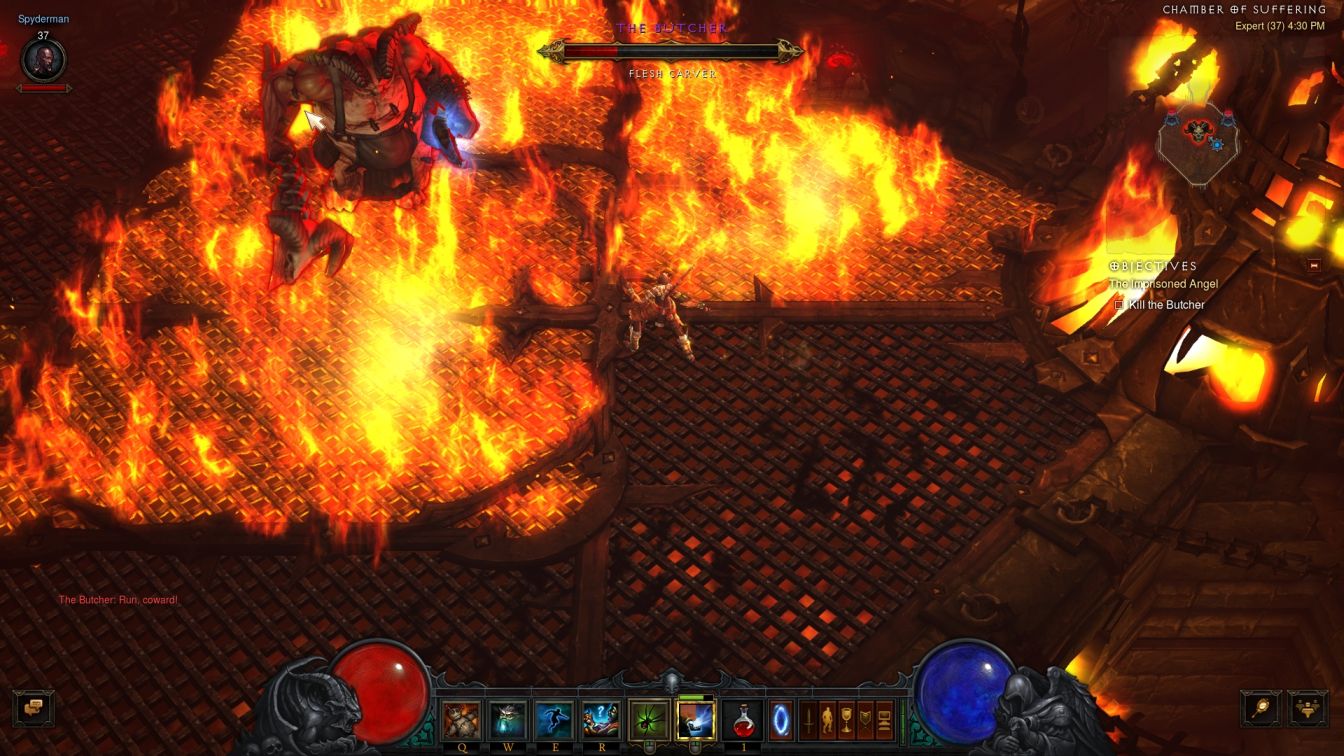
Eventually Spyderman made his way down to the Butcher, the boss guarding the end of Act One. In addition to delivering the iconic "Fresh Meat!" line at the outset of the battle, the Butcher brings a series of attacks that involve hooking the player and pulling them in towards the boss. He also has a heavily telegraphed charge attack, after which the Butcher will be briefly stunned and easy pickings for a series of player attacks. Spyderman didn't have any big attacks with long cooldowns to rain down on the Butcher in these moments, just the same steady damage over time output from throwing dozens and dozens of spider jars. As the battle continues and the Butcher loses health, he will also start setting more and more of the chamber on fire. Like Leoric and Queen Araneae, I discovered in short order that the Butcher didn't have enough damage to get through Spyderman's life regeneration, and so long as I wasn't dumb enough to stand in the furnaces, this was another guaranteed victory. Spyderman kited around in circles, throwing out more spiders and dodging the flames, and after about two minutes the Butcher keeled over for good.
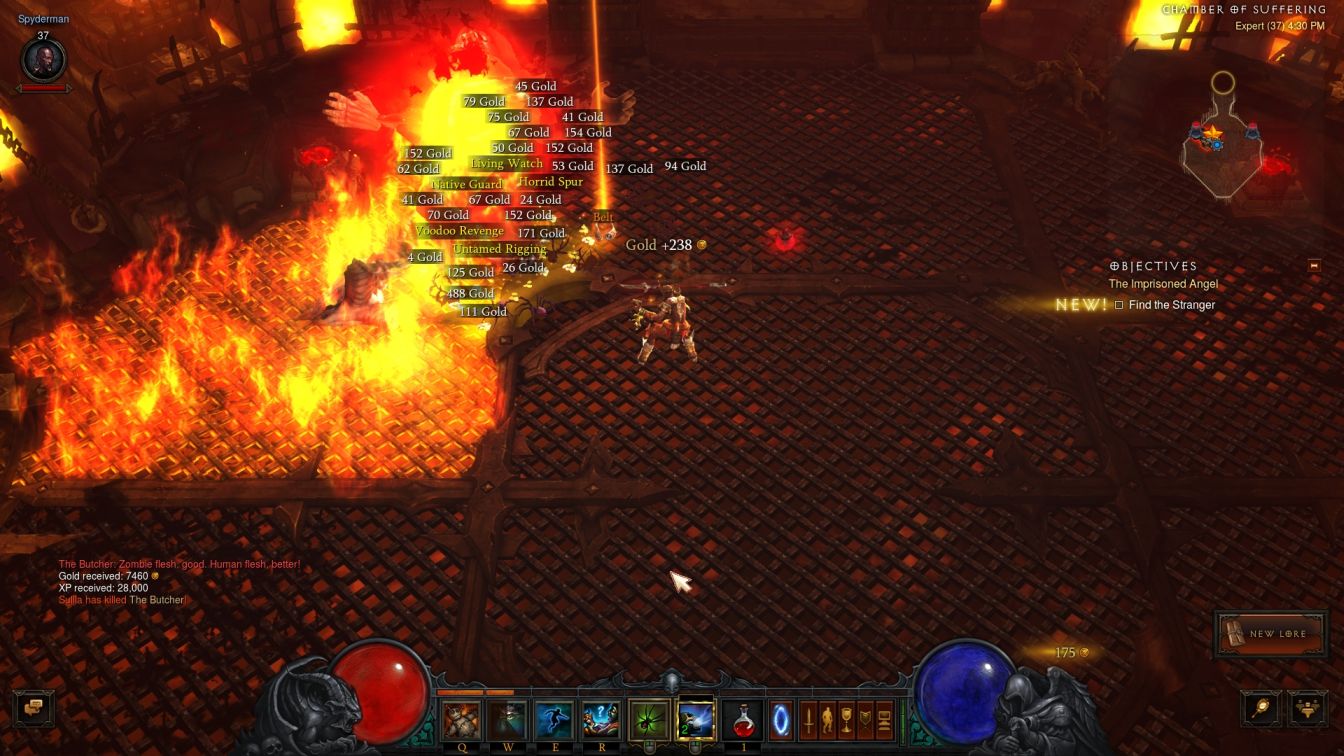
The subsequent loot dropped a series of rares and a legendary belt, with the exact belt being one that I can't remember now. Should have screenshotted it at the time, oh well. The act end bosses are guaranteed to drop a legendary item the first time that they're defeated in Campaign Mode, which is a nice prize for the time invested in reaching them. Spyderman would be moving on to the deserts of Act II, something that felt a little bit too familiar. Hmmm, wasn't there some other Diablo game that sent players to a desert city for Act II? In any case, the Master of Spiders was taking his act on the road and heading off to face new challenges in the days ahead.



